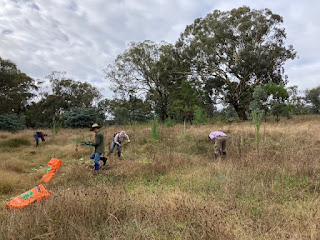The next scheduled Mt Rogers working bee is on Monday 7th March. We’ll meet at Wickens Place, Fraser by 09.00am and return to the task of tackling weed species that will be dispersing their ripening seeds within the next few weeks.
If able to volunteer then please bring secateurs and water to drink.
As you can see from the photo (immediately below) of Roger, Colette, Jennifer, Phil and hidden Ted at work on Sunday 27th, it’s a search and destroy mission for the target species shown in the next photo below:
in order, left - right: Fleabane, Verbascum (Mullein), Thistle andPrickly Lettuce.
The photo just above shows the value of gaiters. Each of these Paspalum seeds has enough hooks to cling to the threads of the fabric. This seed dispersal method was the inspiration for Velcro many decades ago.
Here’s the pile of St John’s Wort (photo below) that was pulled out of the grassland north of Jacob Place, Flynn a few weeks ago. Xtine is now putting the remains in their rubbish bin bit by bit... A really helpful contribution as this noxious weed needs to be deeply buried rather than go to a Green Waste recycling site.
Jennifer is aiming to put up some mini-posters showing what the target species look like. The suburbs are as full of these weed species as the reserves are. They, and hundreds of annual weeds have thrived in the damp conditions from La Nina.
Here are some methodologies for managing the current target species:
Pull St John’s Wort whilst the soil’s still damp and leave in dense piles on top of Phalaris, Paspalum grasses or other undesirable plants in full sun if possible. Some volunteers pile weeds up on the ‘bare' ground under eucalypts where the seeds are less likely to germinate.
Verbascum or Mullein: cut heads off and bag if there’s enough bags and the capacity to carry their weight out of the infestation area. Pile up untransportable heads in one exposed place. Pull plant out if the soil’s damp enough to allow this without causing hernias or back damage. Pile up stems in one or more places also on top of undesirable species. Rosettes of younger plants are daubed with herbicide.
Thistles: cut off any flowerheads that are coloured-up/about to open for pollinators and bag these. Also cut and bag brown heads. Cut the rest of the flowering area of the plant into short lengths. Leave on the ground to 'cook' and then rot down.
Lop the plant close to the soil.
Prickly Lettuce: There’s so much of it that bagging the flowerheads is unrealistic. But cutting flowerheads off and then covering them with the weight and mass of the rest of the plant should prevent any seeds from blowing away.
I also wondered abut getting some sturdy black plastic bags and filling them with Prickly lettuce heads. Then leaving each bag on a patch of ferals to see if the PL rots and then dies by enclosed cooking. Need to retrieve the black plastic bags at some stage.
Fleabane: Green and young plants are pullable at present and leave where they are. If flowering or seeding, cut and bag heads if possible. If not cut flower and seeding heads off, pile them in one place and pile the remains of the plants on top. Pulling up is best but unlike SJW they bring a clod of soil with them which brings light to other seeds in the disturbed soil. Holding down the soil with one foot whilst pulling helps leave half the soil clod in situ, Steve’s found. I’ve felt guilty for some recently when they have moss growing round them. Mosses and lichens are so essential for preventing soil washing or blowing away. Cutting the Fleabane off at ground level will set the plant back but it’s likely to resprout.
Mustard: Pull up the plants if soil’s damp enough and make dense piles of them on top of feral vegetation. TCCS staff did take six woolbags of Mustard away for us in 2020 and piles of SJW from Hall in 2022 but their ability to do this depends on other commitments.
I hope your gardens are free of these invasive species.
Keep a lookout for clusters of privet and ivy seedlings growing under trees, shrubs and along fencelines. They’re easy to pull out when young. The seedlings come from berries that birds feast on in others’ gardens and poo into the reserves when they fly over or perch on trees.
There’s no such thing as low maintenance gardening is there?
Thank you for all your diverse contributions to Landcare,
Rosemary




No comments:
Post a Comment